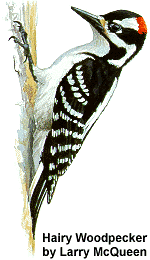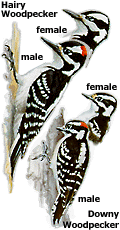
Hairy
Woodpecker
Picoides villosus
Cool fact: Hairy Woodpeckers find their food by feeling the vibrations made by insects moving about in the wood. They also can hear the insects munch on the wood!

Hairy Woodpeckers are between 9 and 13 inches (16.5 to 26 cm) in length. They are a black-and-white woodpecker with a long, chisel-tipped bill. Females are slightly smaller and less bulky than males.
Description: Hairy Woodpeckers have a black forehead and crown; males have a red patch on their nape (see drawing below), whereas females have a black nape. A wide white supercilium with a broad black band extends through the eye to the ear coverts, then down the neck. The moustachial stripe is black, broadening on the neck. A black comma extends from the side of the neck to the upper breast. The chin and throat are white. The lower neck, sides of mantle, rump, and uppertail coverts are black. The back is almost entirely white. The upper coverts are black with large white spots. There is variation in the extent of the white spots across these coverts: with Pacific Northwest, southwestern, and southern races show little white on the wings. Flight feathers have white barring. The tail is centrally black with white outer tail feathers.
Conservation fact: Although stable or increasing in numbers across most of the U.S., the Hairy Woodpecker has become rare and local in Florida and adjacent Georgia, where it continues to decline. In this region, the Hairy is found strictly in mature pine forests and strongly prefers recently burned areas. Natural wildfires play a vital ecological role in the southeastern U.S., and fire suppression by humans has made many species--including the Hairy Woodpecker--become threatened in this region.
A fairly numerous and widespread species, there are 14 recognized races of Hairy Woodpecker in North America. These are distinguished by
- size
- color of pale areas
- amount of white on wing
Eastern race of the Hairy Woodpecker
(adult male)
Male Hairy Woodpeckers have a red band on their nape (left and below), while females (right and above) do not.
(Drawings by Larry McQueen.)Confusion with Downy Woodpeckers.
The range of Hairy and Downy woodpeckers overlaps across North America. Both are black-and-white woodpeckers, but they can be easily discriminated (see drawings to the right).
Hairy Woodpeckers are larger.
Hairy Woodpeckers have bills that are equal to or longer than the length of their head, whereas the Downy Woodpecker's bill length is shorter than its head.
Hairy Woodpeckers have a black comma extending to the upper breast whereas Downy Woodpeckers do not.
The white outer tail feathers of Hairy Woodpeckers are entirely white, whereas Downy Woodpeckers have spotted outer tail feathers.
 Hairy Woodpeckers from the
Hairy Woodpeckers from the
Pacific Northwest (above) show decreased
spotting on wings when compared
to their Eastern counterparts (below).


![]()